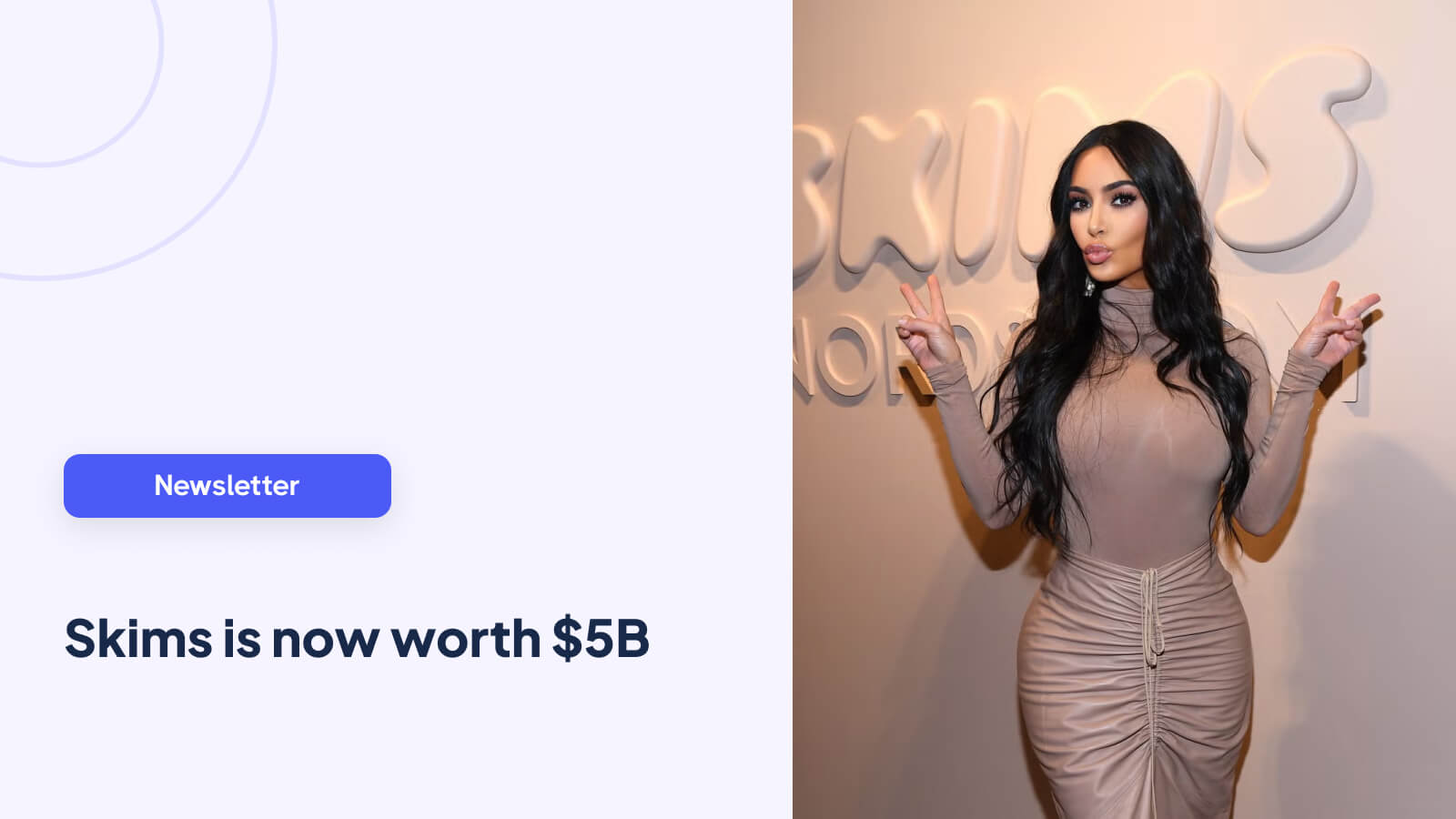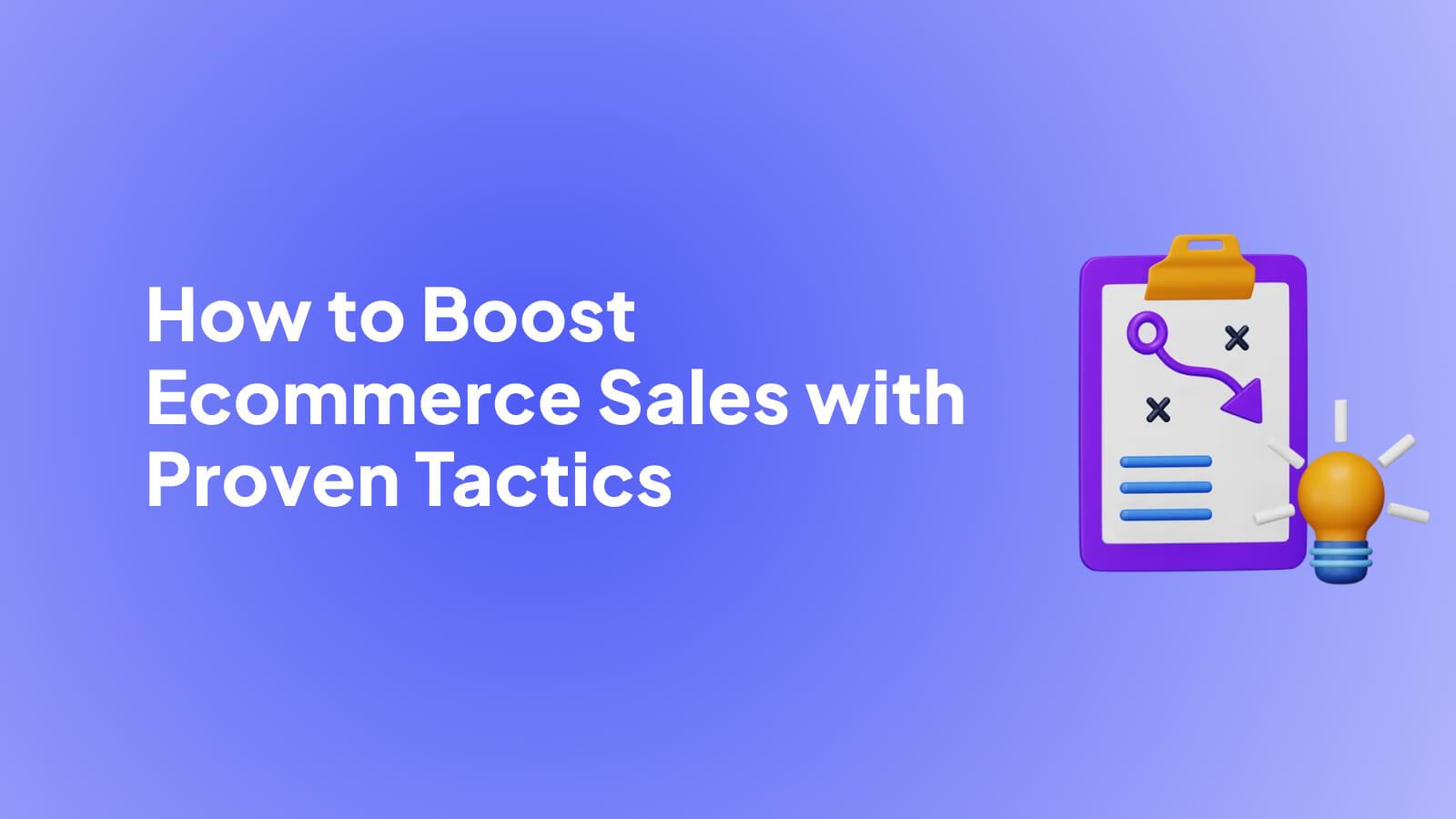
- Your Blueprint for Ecommerce Growth
- Crafting Product Pages That Actually Convert
- Using Shoppable Videos to Drive Engagement
- Building Relationships Through Email and Social Media
- Fine-Tuning Your Store for More Conversions
- Keep the Conversation Going After the Sale
- Common Questions About Boosting Ecommerce Sales
Ready to stop chasing one-off sales and start building real, sustainable growth for your online store? I get it. The e-commerce world is crowded, and it's easy to feel like you're just spinning your wheels.
The truth is, boosting sales isn't about some secret hack or a single magic bullet. It’s about being deliberate and making smart, strategic improvements across the entire customer journey. We're going to walk through a proven framework that covers everything from grabbing a customer's attention to turning them into a loyal, repeat buyer.
Your Blueprint for Ecommerce Growth
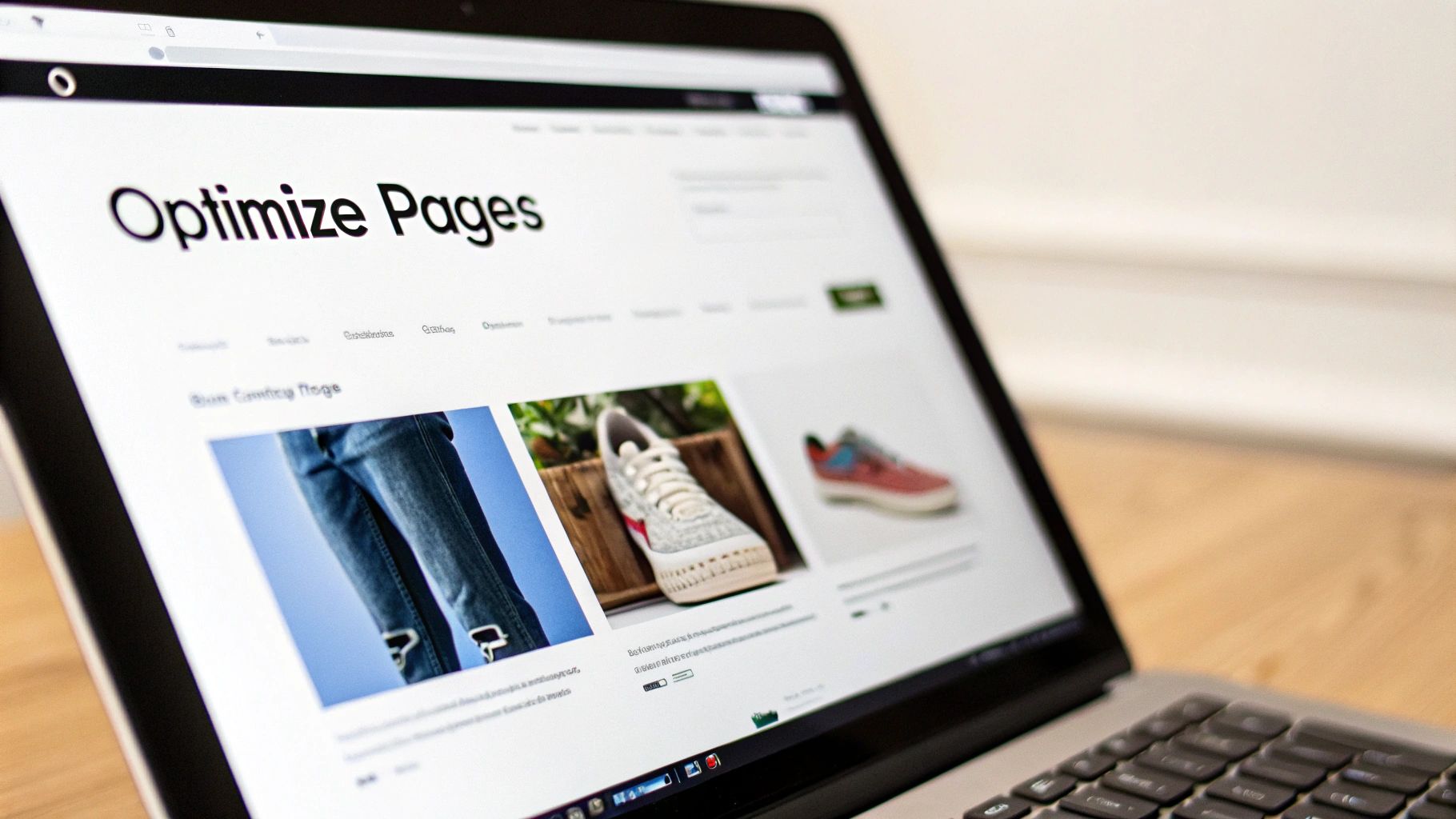
Think of this guide as your playbook. We'll skip the fluff and focus on actionable tactics that deliver results. It all starts with understanding the modern shopper and the environment they're in.
The Reality of Today's Online Shopper
The way people shop has fundamentally changed. Gone are the days of just browsing on a desktop. Today, your store lives in your customer's pocket.
The numbers don't lie. Global ecommerce sales are on track to hit a massive $8.3 trillion by 2025—that's a 55.3% jump from 2021. And where is that growth happening? On mobile. Over 70% of all online purchases are now made on a phone. If you want to dive deeper into these trends, the data on ClearlyPayments.com is eye-opening. This isn't a trend; it's the new standard. Your strategy has to be mobile-first, period.
The most effective way to boost ecommerce sales is to stop thinking like a retailer and start thinking like a customer. Identify friction points in their journey—from discovery to checkout—and eliminate them with seamless, engaging, and personalized experiences.
To give you a clear roadmap for what's ahead, we've broken down the process into five core pillars. These are the fundamental areas where you can make the biggest impact.
To make this easier to follow, here's a high-level look at the core strategies we'll be dissecting. Each one builds on the last to create a powerful growth engine for your store.
Core Pillars for Ecommerce Sales Growth

By mastering these five areas, you're not just aiming for a temporary sales spike. You're building a resilient, customer-focused business that can thrive in any market. Let's get started.
Crafting Product Pages That Actually Convert
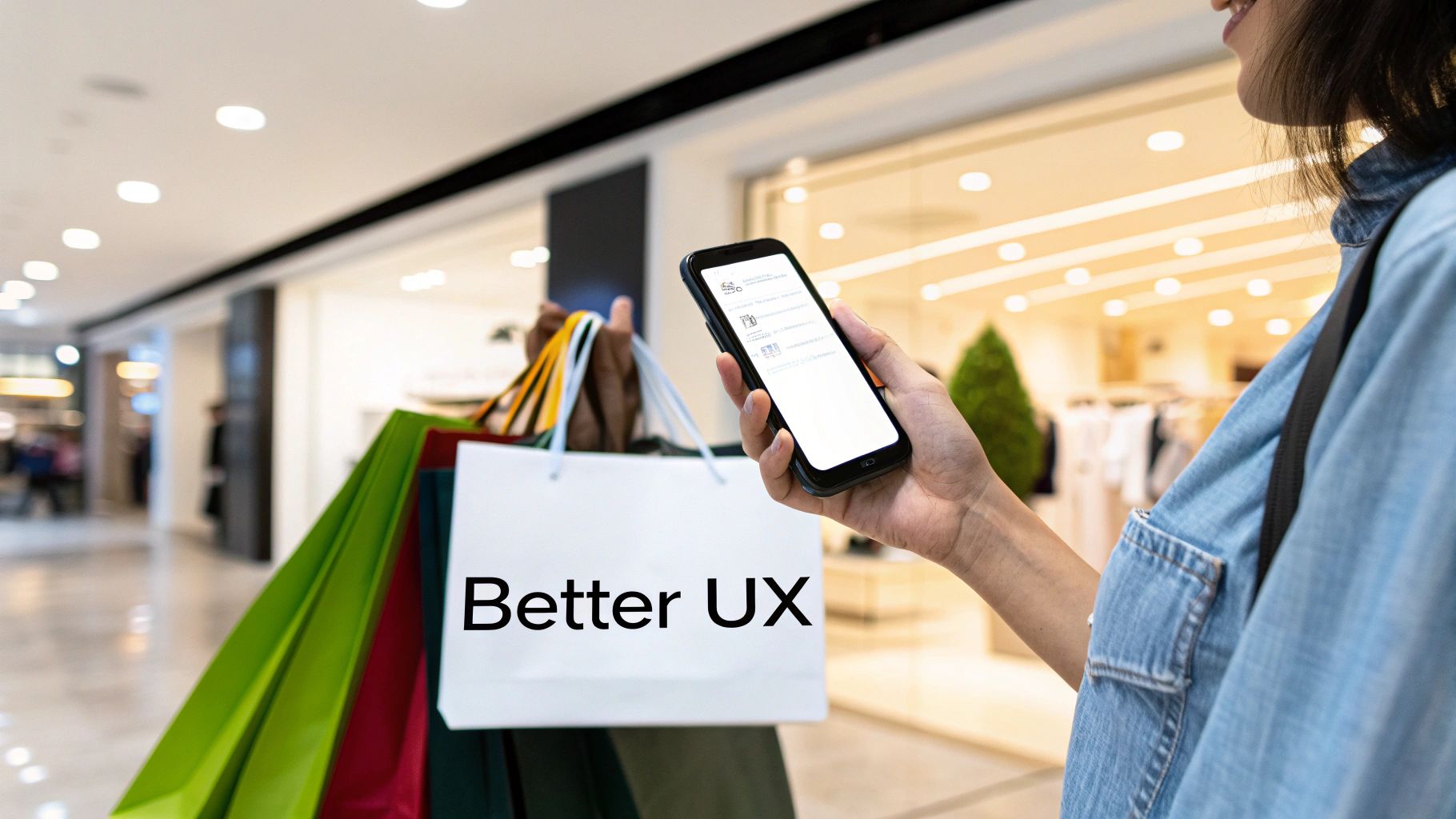
Think of your product page as the final, critical conversation with a customer before they head to the checkout. It's the moment where a casual browser decides to pull the trigger and become a buyer. Every single element on this page either builds their confidence or plants a seed of doubt.
Nailing your product pages is one of the most direct ways I’ve seen to lift ecommerce sales. You’re not just listing features; you're selling an experience. The goal is to anticipate every question a shopper might have and answer it so thoroughly that clicking "Add to Cart" feels like the most natural, smartest decision they could make.
Go Beyond Basic Product Photos
In ecommerce, your photos have to do all the heavy lifting. Customers can't touch or feel the product, so your images need to bridge that sensory gap. A single, flat photo against a stark white background just doesn't cut it anymore.
To really connect, you need to show your product from every conceivable angle. High-resolution photography is the bare minimum. Show the front, the back, the side, and get in close on the details. Imagine how a customer would inspect it in a physical store—they’d pick it up, turn it over, feel the texture. Your photos have to replicate that hands-on experience as closely as possible.
Here's how to create a visual story that sells:
- Lifestyle Shots: Show your product being used in a real-world setting. If you sell a backpack, get it on a hiker's back out on a trail. If it's a coffee mug, show someone enjoying a warm drink on a cozy morning. This helps shoppers picture it in their own lives.
- Scale and Context: Photos can be deceiving when it comes to size. I always recommend including an image that gives a sense of scale, like placing a small gadget next to a smartphone or showing it in someone’s hand.
- Video Demonstrations: Nothing builds confidence quite like seeing a product in motion. A short video can highlight key features, prove its durability, or just offer a 360-degree view that static images can never fully capture.
Write Descriptions That Actually Sell
Let's be clear: your product description's one and only job is to connect the product’s features to the customer’s wants and needs. Stop listing what your product is and start explaining what it does for them.
I've found that the best approach is to blend a compelling narrative paragraph with some easy-to-scan bullet points. Use the paragraph to tell the story behind the product or paint a vivid picture of the problem it solves. Then, use the bullet points to quickly lay out the key features and benefits for people who are just skimming.
Your product page shouldn't read like a technical manual. It should feel like a helpful conversation with a knowledgeable friend who gets exactly what you're looking for.
Build Trust with Authentic Social Proof
Here’s a hard truth: shoppers trust other shoppers infinitely more than they trust brands. That’s why social proof isn't just a nice-to-have anymore; it's a fundamental conversion tool. Authentic customer reviews, star ratings, and user-generated content (UGC) are your most persuasive assets.
- Customer Reviews: Don't just stick them at the bottom of the page. Feature a standout review right near the top. Give shoppers the ability to filter reviews by rating or search for keywords within them.
- User-Generated Photos: Actively encourage your customers to share photos of themselves using your product. Sprinkling these images throughout the product page provides a level of authenticity that polished, professional photos just can't match. It's incredibly powerful to see real people loving what you sell.
- A Clear Call-to-Action (CTA): Your "Add to Cart" button needs to be impossible to miss. Use a bold, contrasting color that pops off the page and stick with clear, action-oriented text.
With retail ecommerce projected to account for 20.5% of all retail sales worldwide by 2025, the digital storefront is where the action is. This massive shift means that optimizing these pages is more critical than ever. As you can see from the growth of ecommerce sales on Backlinko.com, every small tweak you make is a chance to better connect with this massive, growing audience and claim your piece of the market.
Using Shoppable Videos to Drive Engagement
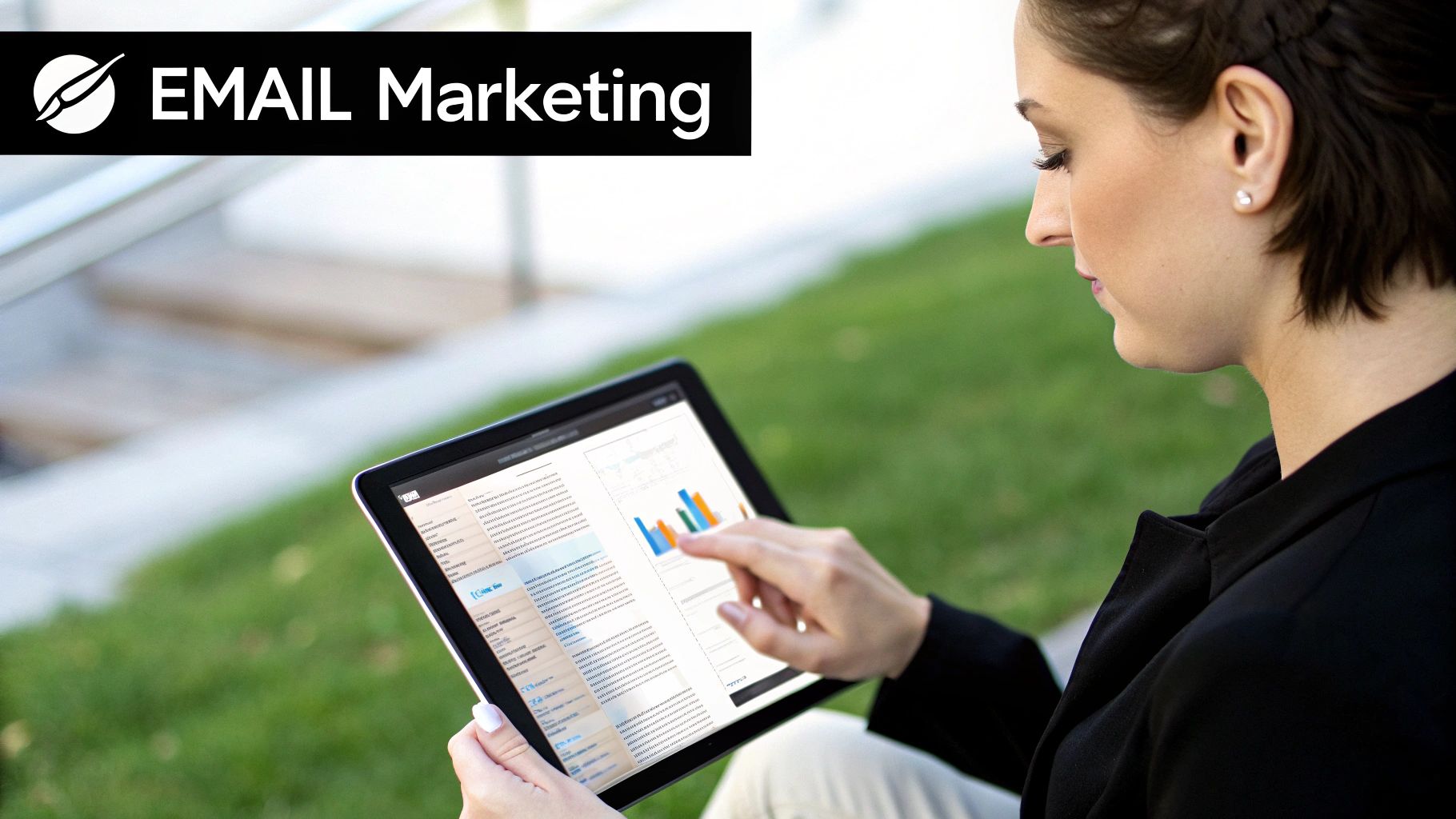
If your product pages are still just a wall of static photos, you're leaving a massive opportunity on the table. Shoppers today expect more. They want dynamic, engaging content that doesn't just show a product—it brings it to life. This is where interactive video comes in, and it's completely changing how smart brands boost their ecommerce sales.
Shoppable videos are so effective because they collapse the entire sales funnel into a single moment. A customer sees a product they love in a video and can add it to their cart right then and there, directly from the video player. This "see it, want it, get it" flow eliminates friction and captures that critical buying impulse the second it strikes.
Turning Passive Viewers into Active Buyers
The goal here is to stop people from just passively watching and get them to take action. When someone is engaged with a product video, their interest is at its absolute peak. Adding a simple clickable hotspot or a "Buy Now" button inside the video turns that fleeting moment of excitement into an immediate conversion.
Put yourself in the customer's shoes. You're watching a tutorial on a new skincare routine or a style guide featuring a jacket you love. The instant you think, "I need that," you can act on it. This immediacy is a powerful conversion driver. From what I've seen, brands that do this well see a real, measurable lift in engagement and add-to-cart rates simply by making the path to purchase ridiculously short.
For example, a clothing brand can create a Reel-style video showcasing a complete outfit. As the model moves, clickable tags can pop up on the jacket, the jeans, and the shoes, letting viewers explore each item without ever leaving the video. You can actually see how some leading Shopify stores are boosting sales with shoppable video for more real-world inspiration.
Creating Immersive Product Experiences
Beyond just a simple "buy" button, interactive content can build a ton of purchase confidence and solve common customer problems. This is where you get into more advanced tools like 360-degree viewers and augmented reality.
- 360-Degree Product Viewers: These let customers digitally "pick up" an item and inspect it from all sides. For any product where the little details matter—like the texture on a handbag or the port layout on a laptop—this provides a level of clarity that flat photos just can't compete with.
- Augmented Reality (AR) Try-On: AR is one of the best ways to close the gap between online and in-store shopping. It lets customers use their phone's camera to see exactly how a couch would look in their living room or how a pair of sunglasses fits their face.
AR try-on features have been shown to increase conversion rates by as much as 94% in some cases. When you let customers "try before they buy" virtually, you eliminate the guesswork, which calms purchase anxiety and dramatically reduces the chance of returns.
Guiding Customers with Interactive Quizzes
Another fantastic way to use interactive content is to guide shoppers to the right product for them. A well-crafted quiz feels less like a sales tactic and more like a personalized consultation, which is an incredibly effective way to boost ecommerce sales, especially if you have a large or complex catalog.
Think about a beauty brand with dozens of foundation shades. Instead of making a customer guess their match and hope for the best, an interactive quiz can ask a few quick questions about skin tone and type. At the end, it recommends a few perfect matches, complete with shoppable links. This not only makes the decision easy for the customer but also creates a helpful, memorable experience that builds real brand loyalty.
Building Relationships Through Email and Social Media
If you want to seriously boost your sales, you need to stop thinking about marketing as just a series of promotions. The real goal isn't just getting new customers; it's about building a loyal community that sticks around. Email and social media are your direct lines to that community, but only if you use them to build a real connection, not just to shout about your latest sale.
Forget the generic, one-size-fits-all approach. The brands that are truly winning are the ones that make their customers feel seen and understood. This means going beyond basic campaigns and setting up personalized, automated experiences that meet people exactly where they are.
Architecting Automated Email Sequences That Convert
Your email list is pure gold. It’s a direct channel to people who have already raised their hand and said, "I'm interested." But if all you're doing is sending the occasional promotional blast, you’re leaving a ton of money and loyalty on the table.
Automation is where the magic happens. By setting up specific email sequences, you can send the perfect message to the right person at the right moment. It feels personal and relevant because it is. These automated flows work for you around the clock, nurturing leads and pulling back potentially lost sales without you lifting a finger.
Here are the must-have sequences for any ecommerce store:
- The Welcome Series: This is your first impression when someone new subscribes. Don't just toss them a discount code and call it a day. Use a three-to-five-part series to tell your brand story, highlight your bestsellers, and share something valuable that builds trust right from the start.
- The Abandoned Cart Sequence: Did you know that nearly 70% of online shopping carts are abandoned? That's a staggering number. A timely, well-written email sequence is your best shot at getting a huge chunk of that revenue back. Remind them what they liked, maybe tackle a common objection like shipping costs, and create a little urgency to get them over the finish line.
A strong email strategy is about starting a conversation, not just making a sale. When you deliver value and personality straight to the inbox, you turn subscribers into fans and fans into repeat customers who feel like they're part of something.
For a much deeper dive into setting these up, check out our guide on 5 effective email sequence examples for boosting e-commerce sales. It's filled with practical templates you can borrow and adapt.
Creating Social Media Content That Actually Engages
Social media is a totally different ballgame. People aren't scrolling through their feeds looking for ads; they're there for entertainment, inspiration, and connection. The brands that crush it on social are the ones creating content that feels like it belongs there—it's authentic and adds something to their followers' day.
This means you’ve got to ditch the overly polished corporate look. Get a little more human. Give people a peek behind the curtain with Instagram Stories. Create short, helpful TikToks that solve a problem your customers have. The aim is to build a community, not just rack up followers.
To really drive sales from social media, focus on these two game-changers:
- Embrace User-Generated Content (UGC): Get your customers to share photos and videos of themselves using your products. When you feature UGC on your own feed, it’s the ultimate social proof. It's real, it's trustworthy, and it shows potential buyers that people just like them already love what you sell.
- Partner with the Right Influencers: Working with influencers can be a fantastic way to reach new, laser-targeted audiences. The trick is finding partners whose audience and values are a perfect match for your brand. A genuine recommendation from a creator they trust can outperform a dozen of your own paid ads.
The entire retail world is moving online, and it's not slowing down. In the United States during Q1 2025, ecommerce sales jumped 6.1% year over year—a growth rate about 1.5 times faster than total retail. You can explore more of these ecommerce trends on Census.gov. Building these digital relationships is exactly how you claim your piece of that ever-growing pie.
Fine-Tuning Your Store for More Conversions
Getting people to visit your store is a great start, but it's only half the job. If those visitors leave without buying, you're leaving a lot of money on the table. This is where Conversion Rate Optimization (CRO) comes in—it’s the process of turning the traffic you already have into paying customers.
Think of it this way: CRO is about making small, smart tweaks to your site based on real customer behavior, not just guesswork. It's how you move from thinking you know what shoppers want to knowing what actually makes them click "buy."
See Your Store Through Your Customers’ Eyes
Before you can fix anything, you have to understand what’s broken. That means seeing your website from your customer’s perspective. Where are they getting confused? What’s making them hesitate?
Thankfully, you don’t have to guess. There are some incredible tools out there that give you a behind-the-scenes look at how people really use your site.
- Heatmaps: These tools are fantastic. They create a visual map showing you exactly where people click, move their mouse, and how far down the page they scroll. A heatmap might quickly reveal that your most important shipping information is "below the fold," where 80% of visitors never even see it.
- Session Recordings: Imagine being able to watch a replay of a customer’s entire visit. Session recordings let you do just that. You can watch real, anonymized users navigate your site, seeing every click and scroll. A few of these recordings will often expose frustrating usability issues you never would have caught on your own.
Once you’ve spotted a problem—like a ton of people abandoning their cart right after seeing the shipping costs—you can start thinking about a solution.
The image below shows just how powerful a few targeted changes can be. It highlights a massive jump in both conversion rate and average order value after a business implemented changes based on this kind of data.
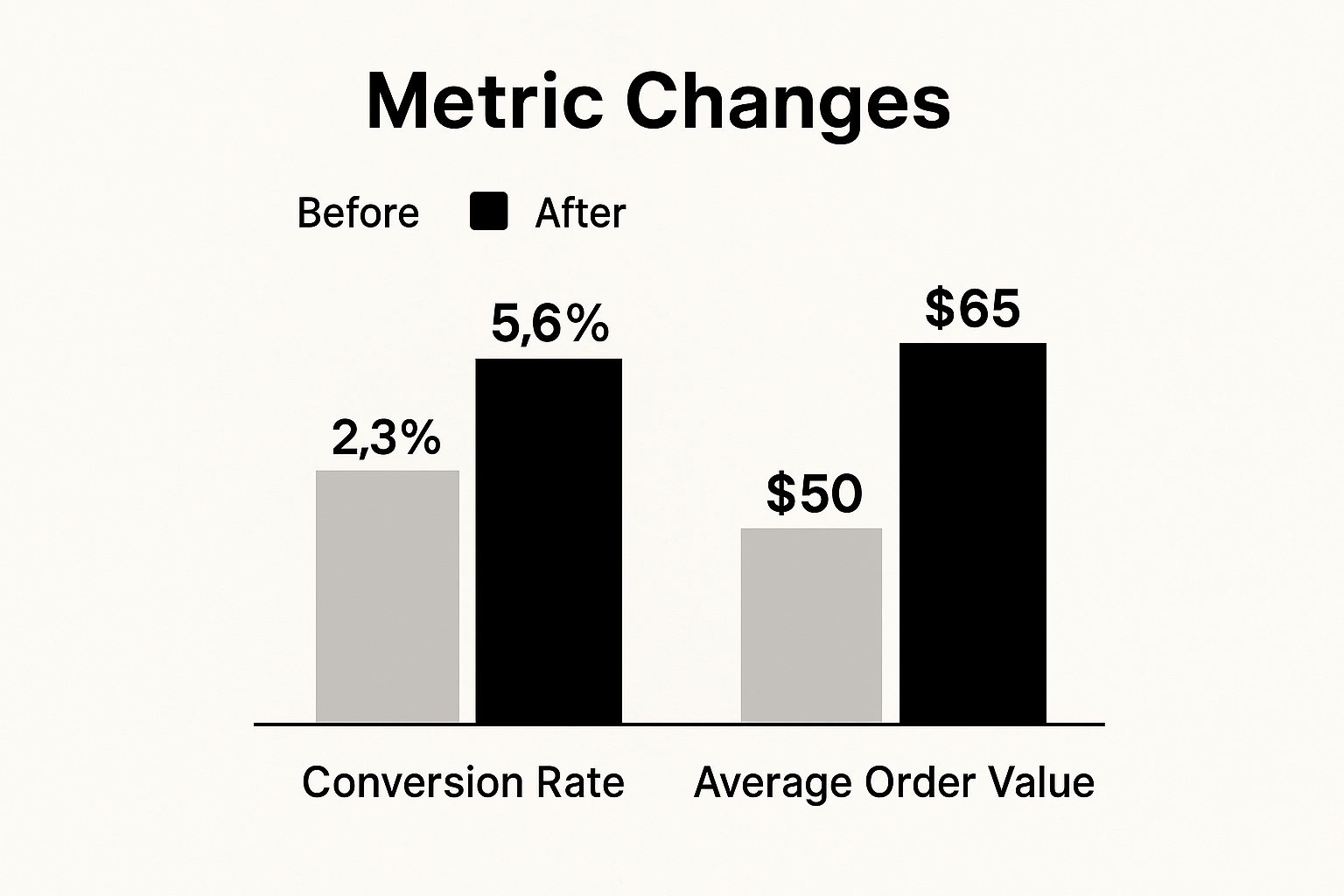
This really drives home the point that a small optimization doesn't just get more people to buy; it can also encourage them to spend more each time they do.
From Good Guesses to High-Impact A/B Tests
Once you've identified a potential issue, it's time to form a hypothesis. This isn't just a random idea; it's a clear, testable statement about what you're going to change, why you're changing it, and what you expect to happen.
Here’s a solid hypothesis: “We believe that changing the main CTA button on our product pages from grey to a high-contrast orange will increase add-to-carts by 15%. The current grey button blends into the page, and a vibrant color will create more visual urgency.”
With a clear hypothesis in hand, you're ready to run an A/B test (sometimes called a split test). You’ll show the original page (the 'A' or control version) to half your visitors and the new, updated page (the 'B' or variation) to the other half. Then, you simply measure which one performs better.
You can test almost anything, but your time is valuable. Start with changes that could have the biggest impact on your revenue.
A/B testing is a powerful way to make data-driven decisions instead of relying on gut feelings. By creating two versions of a page element and showing them to different segments of your audience, you can definitively see which one performs better.
A/B Testing Ideas for Key Ecommerce Pages

Testing different elements like this gives you concrete evidence of what resonates most with your audience, helping you build a more effective customer journey from start to finish.
The most important rule? Only test one thing at a time. If you change the headline, the button color, and the product description all at once, you’ll have no idea which change actually made the difference. By testing systematically and implementing the winners, you create a powerful cycle of continuous improvement.
For a deeper dive, our guide on how to increase your ecommerce conversion rate is packed with more advanced strategies.
Keep the Conversation Going After the Sale
Too many brands treat the "thank you" page as a dead end. Big mistake. That moment, right after a customer clicks "buy," is actually the starting point for your next, and potentially most profitable, relationship. This post-purchase window is pure gold for turning a first-time buyer into a lifelong fan.
After all, it's far cheaper to keep a customer you already have than to go out and find a new one. A smart upsell or cross-sell right on the confirmation page or in that first email can do wonders for your average order value. The trick is to be genuinely helpful, not just salesy.
Turn That First Purchase into a Real Relationship
Instead of just blasting them with more products, think about what would actually improve their experience. Someone just bought a new tent? Suggest a high-quality sleeping bag or a portable lantern. It’s a natural fit. You're not just pushing more stuff; you're helping them get the most out of their original purchase.
I've always found that the best post-purchase offers feel like a thoughtful recommendation from a friend. When you offer relevant products that truly complement what they just bought, you're building trust and enhancing their experience with your brand.
Once that initial post-purchase excitement wears off, your goal shifts to building a long-term connection. This is where you lay the groundwork for repeat business and start to seriously increase their customer lifetime value (LTV). For a deep dive, we've put together a full guide on how to increase customer lifetime value.
Build Loyalty and Predictable Revenue
Getting customers to come back again and again is the secret to a stable, profitable business. Two of the most reliable ways to do this are with loyalty programs and subscriptions.
- Launch a simple loyalty program. It doesn't need to be complicated. A basic points system for purchases, reviews, or even social follows can be incredibly effective. It gives people a real reason to choose you next time.
- Offer "subscribe and save" options. If you sell anything consumable—think coffee, skincare, pet food, you name it—a subscription model is a no-brainer. It’s convenient for them and creates a steady, predictable income stream for you.
One of the most powerful things you can do is implement well-designed customer loyalty programs that make people feel valued. When you reward your best customers, they don't just buy more; they become advocates who bring you new business for free.
Common Questions About Boosting Ecommerce Sales
Even with the best strategy laid out, you're bound to run into questions. It happens to everyone. Let's walk through some of the most common things I hear from store owners so you can keep moving forward without getting stuck.
What’s the Quickest Way to Get a Sales Lift?
If you're looking for the fastest impact, don't look for something new—optimize what you already have. Your highest-traffic product pages and your checkout flow are gold mines for quick wins.
It sounds almost too simple, but running a basic A/B test on your main "Add to Cart" button can make a real difference. Try changing the color or tweaking the text. I've seen simple changes like this produce a measurable lift in just a couple of weeks, all without spending a single extra dollar on ads.
Another incredibly effective tactic is setting up an abandoned cart email sequence. The data doesn't lie: nearly 70% of shopping carts are abandoned. By setting up a simple automated email to remind those shoppers, you can recover a chunk of that lost revenue almost immediately.
It's easy to get caught up in chasing more traffic, but don't underestimate the power of small, iterative improvements. I've found that improving your conversion rate by just 0.5% can have a much bigger financial impact than a 10% traffic boost—and it's often a whole lot easier to pull off.
How Much Should I Actually Spend on Marketing?
There’s no magic number here. The right budget really depends on your industry, profit margins, and where you are in your growth journey. For a general ballpark, many ecommerce brands start by allocating 7-12% of their total revenue to marketing.
But honestly, a much smarter way to think about it is to focus on your Customer Acquisition Cost (CAC) versus your Customer Lifetime Value (LTV). As long as your LTV is significantly higher than your CAC—a healthy ratio is often cited as 3:1—then your marketing spend is profitable.
So, instead of getting hung up on a fixed budget, focus on performance. If a channel is bringing you profitable customers, keep feeding it.
How Often Should I Run Sales or Promotions?
This is a tricky one because it's easy to overdo it. Running discounts too often can seriously devalue your brand and basically train your customers to never pay full price. A more strategic approach is always better.
Here’s how I like to break it down:
- Go big for major events: Plan your biggest sales around key holidays (like Black Friday) or seasonal shifts that make sense for your products.
- Create urgency with flash sales: Use smaller, exclusive promotions for your email list or social media followers. This not only creates a sense of urgency but also rewards your most loyal fans.
The whole point is to make promotions feel like a special event, not an everyday thing. This keeps your brand's perceived value high while still giving you a powerful tool to drive sales when you need it.
Ready to turn your product videos into a sales machine? Moast lets you add shoppable videos to your store in just minutes, completely free. Start converting more viewers into buyers today. Learn more at https://www.moast.io.
Related content
Turn your videos into sales
Boost conversions by up to 30% by turning your existing TikToks and Reels into shoppable videos directly on your Shopify store.




.jpg)

